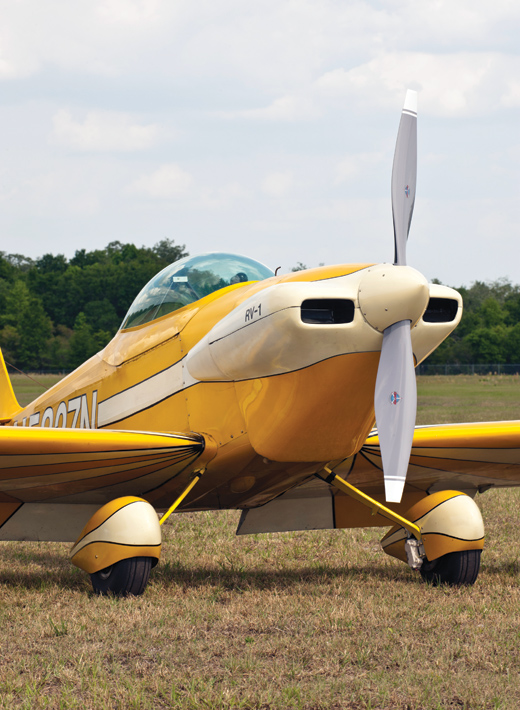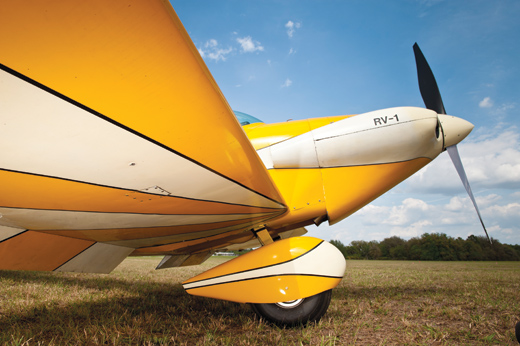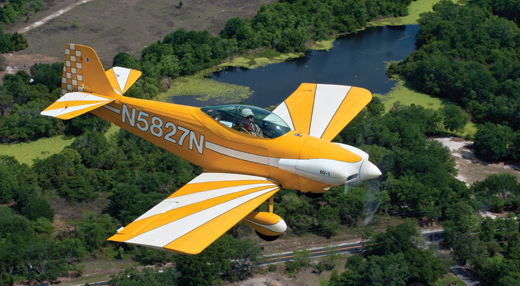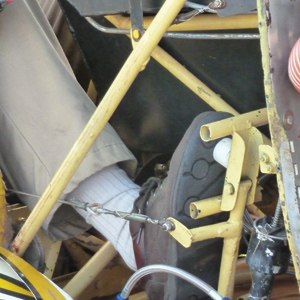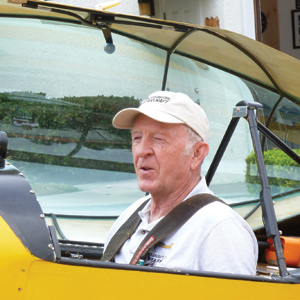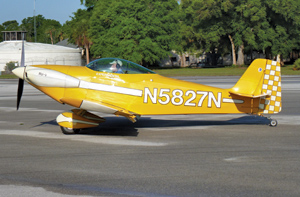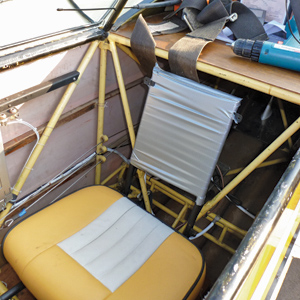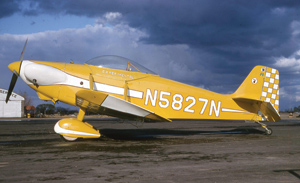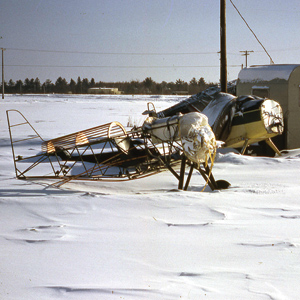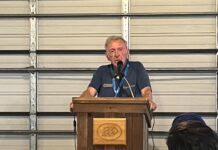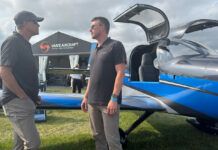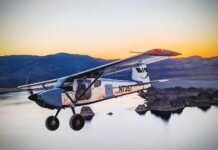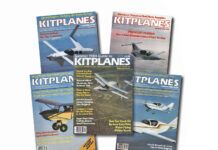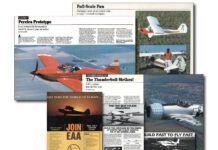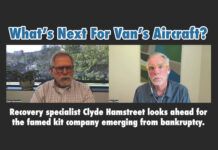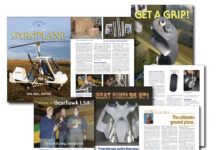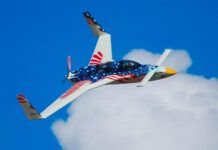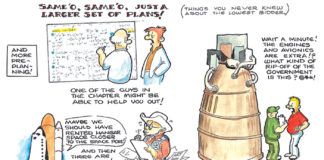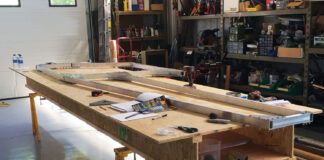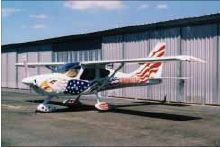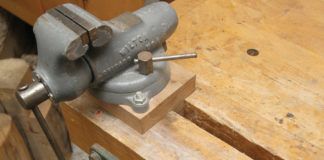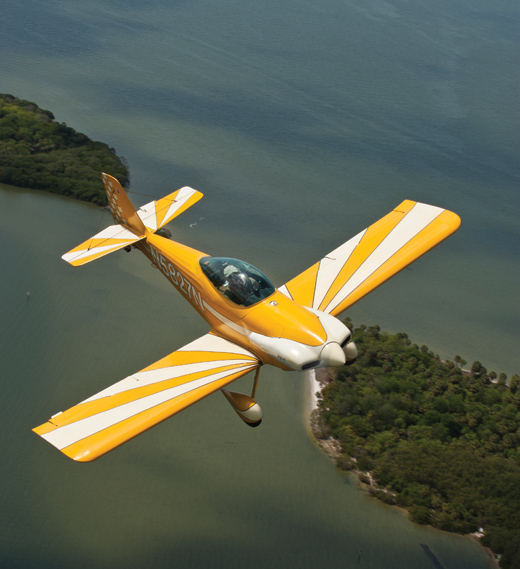
When we read stories about classic airplane restorations, they usually include detailed descriptions about how every nut and bolt was replaced with new hardware, paint on every component was restored to a mirror finish, the airframe was powder-coated or painted to last a thousand years, and every rib stitch was redone to be a work of art so that the overall effect cried out Gold Lindy—and appropriately so. The restoration of a factory-built airplane should reflect the highest level of craftsmanship attained in the day it was built, to shine a light upon its predecessors.
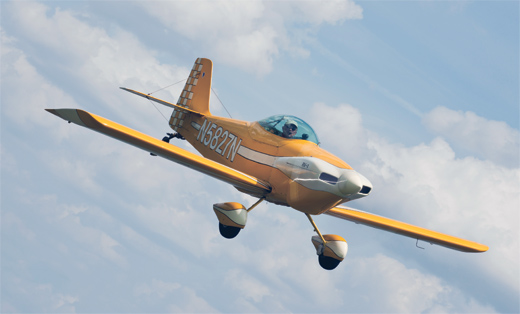
Restoring the RV-1 was a different—and more interesting—challenge right from the start. The reason is that the group doing the work was forced to decide what “restoration” really meant. The RV-1 was (and is) a prototype, an Experimental aircraft in the true sense of the word. Starting life as a Stits Playboy, it was purchased by a young Richard VanGrunsven (“Van”) in 1964 to satisfy his desire to build an airplane that would outperform the standard homebuilts of the day. While Pietenpols and Baby Aces were fun and relatively easy to build in a garage workshop, he wanted something with a bit more pizzazz, so he purchased a non-flying airframe that no longer had an engine and went to work. He modified, and he made it his own. And with every modification came paint, new fiberglass and touch-ups. The project was a work in progress, and while Van was justifiably proud of the airplane, it was not what we would consider “show quality” today. There were changes upon changes, and those almost always leave scars. Airworthy? Yes. Revolutionary? Yes. Cosmetically perfect? Well, that wasn’t a top priority.
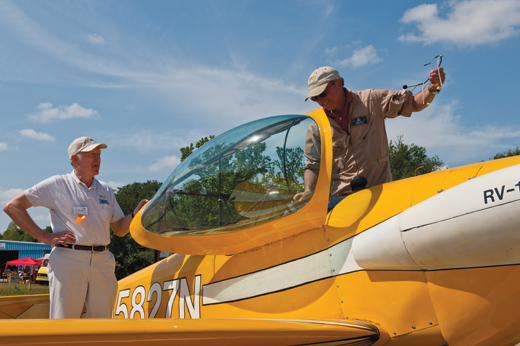
Richard VanGrunsven (left) greets the author after Dye first taxied the restored RV-1 into Sun ‘n Fun 2012.
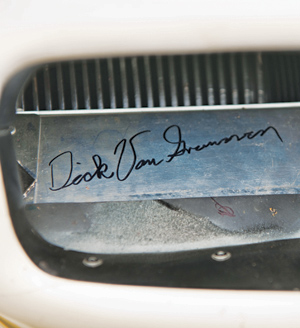
Volunteers signed various parts of the engine baffles during the restoration in Texas. VanGrunsven added his signature at Sun ‘n Fun.
Assessing the Project
As the Friends of the RV-1 volunteers began to work on the airplane, making it airworthy once again was our goal. When I was fortunate enough to be exposed to the airplane (and that exposure led to the eventual acquisition), the airplane had a few engine issues; it wasn’t running properly, and the owner had been unable to solve the problem. With a national tour planned (one that would require 100 or more hours of flying), the airplane had to reliably make its way into and through the air. And while it needed to look good, it also needed to look like it did when Van sold it back in the late 1960s. Perfect paint was not in the cards, but functional mechanicals, necessary avionics and sound structure were all on the to-do list.
When the organization received the airplane, it had not flown for some time. To make the airplane safe and airworthy, the engine issues obviously needed to be fixed, so a complete teardown of the power system was called for. From the fuel cap to the propeller, the group went through everything with a fine-tooth comb. In addition, the entire airframe was scheduled for a thorough cleaning and inspection. We immediately noticed significant play in the control system, a problem blamed on wear in the stick bushings and associated mounts. The plexiglass canopy was badly cracked, the skirt unserviceable and the frame had been drilled so many times that there was no structural place for new holes. The aluminum belly had been the victim of a hard landing that damaged a gear leg and left the pan crumpled. Hoses were ancient, wiring was even older, and a borescope inspection revealed a few surprises in the tail: a large wasp nest and some items that had gone missing from a former pilot’s pockets.
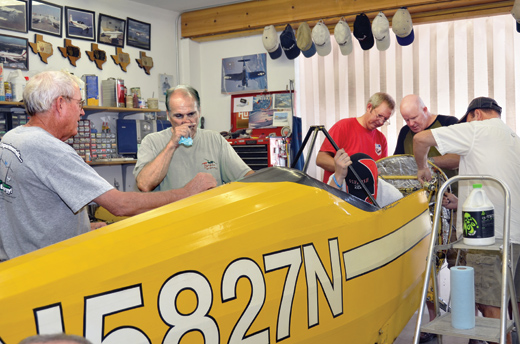
A crowd of volunteers began the restoration by disassembling and opening up the aircraft for a complete inspection.
Team Building and Setting Priorities
The first step on the road to restoration was to find people to do the work, along with a location for the project. The RV community is large: With close to 8000 flying aircraft and several times that number of kits in circulation, the talent pool and resources necessary were out there. The airplane was already located in Texas, so it was only natural for the work to be centered at a builder’s assistance center in Fort Worth known as “RV Central.” Owned and operated by Jay Pratt, the facility had helped provide building space, tools and knowledge for many RV projects over the years, and it proved to be an ideal location. The fact that the Dallas/Fort Worth metroplex is home to hundreds of experienced builders meant a ready supply of eager volunteers.
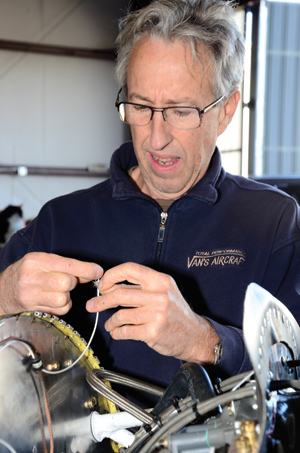
All wiring was replaced by a new system designed, fabricated and installed by Walt Aronow.
It was clear from the start that in addition to workers, tools and a location, it would take a lot of parts and supplies to make the RV-1 fly again. Fortunately, the RV community is also blessed with a large number of suppliers who were ready, willing and able to help. All it took, throughout the project, to acquire the necessary parts and supplies was a phone call to any one of these companies. In fact, the organization’s total bill for outside services and parts was almost negligible when all was said and done. When you consider that this included items like a custom-blown canopy (made-to-match measurements taken from old photos), a scratch-built exhaust system, and a complete engine teardown, reassembly and checkout—well, the generosity was simply unsurpassed.
The Work Begins
The work at RV Central began with the removal of the engine and pretty much everything else forward of the firewall. The engine, a much-modified Lycoming O-290, was crated up for shipment to Aerosport Power in Kamloops, British Columbia. Aerosport builds engines for RV builders all over the world and has a reputation for outstanding work and a deep knowledge of what makes Lycomings tick. Van’s original engine started out as a Ground Power Unit O-290-G, but it had been modified along the way with a different accessory case to allow the use of an oil cooler. While it has been said to be closer to a “D” model at this time, it’s still part of the O-290 family. Along with the engine, the exhaust, engine mount and hoses were all removed so that the various modifications could be evaluated and a coherent plan for the new firewall-forward package could be formulated.
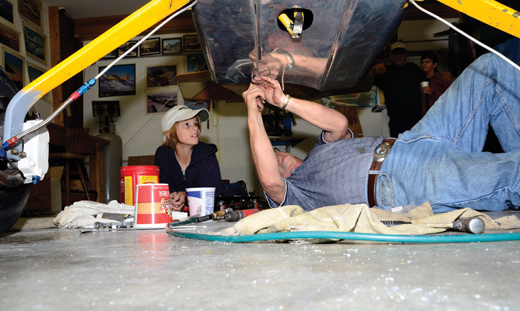
Many volunteers brought along young helpers who got their first exposure to working on an historic aircraft. Here, Tate Reeves assists Stan Price as they fit the new belly pan to the RV-1.
Because Van had modified the airplane a number of times, trying different intakes and cooling strategies, we decided that the best thing to do under the cowl was to build a reliable package that would see the airplane through the tour, regardless of whether it was authentic. The addition of a starter and small alternator were high on the list to make the airplane more self-sufficient on the road. Other than that, the idea was to simplify, so the plenum that had been added long after Van owned the airplane was removed, and plans were made to use standard baffles. We kept the direct-drive tach cable, but we discarded the rest of the cabling and plumbing and the old gascolator. Patching the well-worn firewall took an entire day; many holes had been drilled and punched over the years for indeterminate reasons, and each had to be plugged with a bolt and washer to provide some level of protection for the cockpit. The old carb heat cable was removed (it was actually labeled “choke,” but we figured that was just an indication of the cable’s humble origins), and the throttle and mixture cables were replaced.
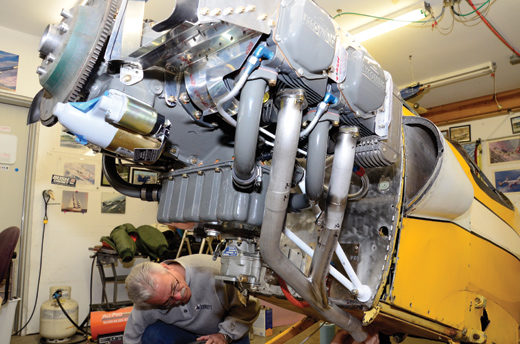
Everything forward of the firewall was refurbished or replaced. Van’s provided the baffles, and Larry Vetterman built a custom exhaust. Hoses, wiring and electrical components were provided by various vendors. (Roy Geer inspects the carburetor here.)
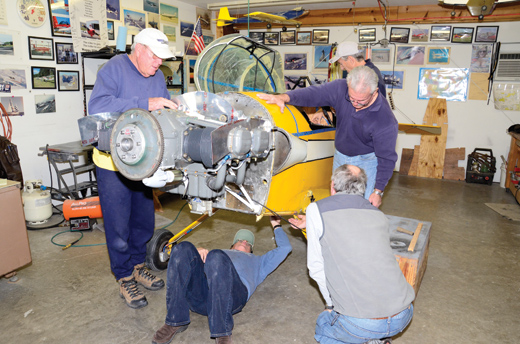
Once the engine was reinstalled, the reassembly work kicked into high gear.
Multitasking
While one team worked forward of the firewall, a second team of volunteers pulled everything that could be removed behind it, back to the cockpit. The boot cowl came off to allow removal of the 22-gallon fuel tank, and the instrument panel quickly followed; it was spirited away for refinishing and cleaning. The aluminum belly pan was removed, along with the floorboards, and a team was assigned to clean the decades of accumulated gunk off of all the steel tubing in the forward part of the fuselage. At this point a crucial decision had to be made. Stripping the fabric and recovering the fuselage would take a huge amount of time and effort, resources the team might not have. To make a good decision, builders knowledgeable in steel tube and fabric construction (rare in the mostly metal RV world) examined the frame and covering. Fortunately, they pronounced everything sound and airworthy. A great sigh of relief rippled through project management, as it looked like Sun ‘n Fun 2012 was still feasible.
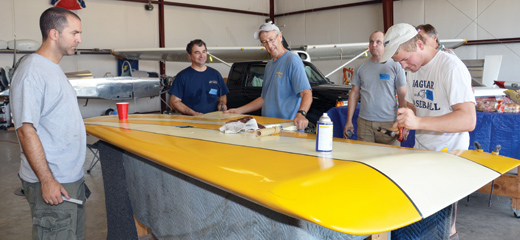
The flaps and ailerons were removed, the wings inspected, and everything was reassembled with fresh hardware.
The elevator hinges had minor surface corrosion, and at least one of the horizontal stabilizer brace wires had cracked brackets, so the control surfaces came off for a general cleanup and inspection. New brackets and fittings were fabricated to replace those that appeared a bit dodgy, and the wires were tuned to a nice constant pitch.
The metal wings, the heart of what made the Playboy into the RV-1, were in excellent condition. There were a few easily patched cracks in the root rib; beyond that, all that was necessary was some rust removal on the steel flap fittings and a good cleaning. If we’d had unlimited time and resources, the wings could have been stripped to bare metal and a great deal of body filler removed to lighten the load, but the schedule didn’t allow such a luxury, and the paint was deemed adequate for the upcoming tour.
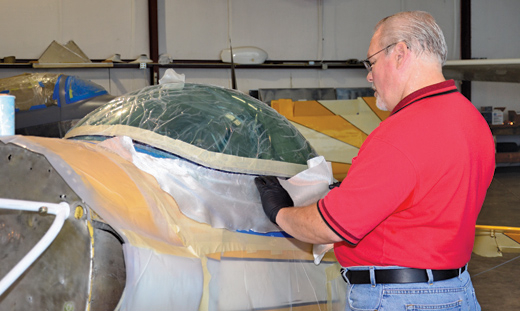
A custom canopy was blown to measurements taken from early photos by Airplane Plastics, an entirely new frame was built by Bob Avery, and a new skirt was formed by Gary Hunter (shown).
A Long-Term Commitment
One should not get the impression that all of this work was performed in a short period of time. The actual restoration began in early fall 2011 and continued through February 2012, with much of the most difficult work done in January and February, after the engine returned in late December. Regular weekend work parties were scheduled, and RV builders flew in from as far away as California, Alabama and Nebraska to contribute their time and talent. Close to 100 different people worked on the RV-1 during its restoration, including father/son teams that allowed a couple of young aspiring pilot/builders to participate in bringing this historic airplane back to flying condition.
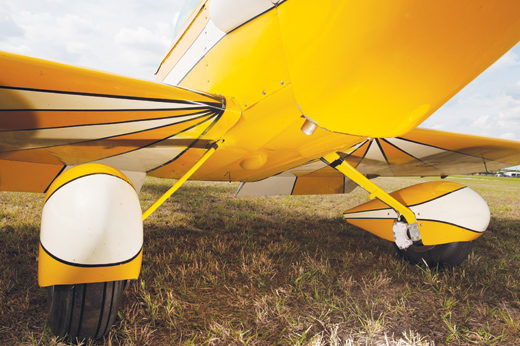
Van personally contributed to the restoration by making the wheelpants for RV-1’s 6.00×6 gear, matching the original wheelpant configuration. He still had the original molds.
Contributions of equipment and supplies magically appeared. The new canopy was mated to a new frame that was custom-made by Bob Avery of Avery Tools to match the original. Composite builder Gary Hunter molded a new canopy skirt out of fiberglass. Avionics technician Walt Aronow replaced all of the wiring with materials donated by SteinAir. The firewall-forward assembly and fabrication work was led by RV-8 builder Danny King, with help provided by many builders. Much fabrication was done by local builder/pilot Roy Geer, who lives just a few hangars down from RV Central and was often called on for help. When it was pointed out that the 5.00×5 wheels, tires and brakes on the airplane were much smaller than the 6.00×6 gear that Van originally had on the airplane, Jay Pratt volunteered a complete set of wheels and brakes off of his Cessna 180. Desser Aircraft Tire & Rubber Company provided tires and tubes, and the folks at Grove provided new axles. A new prop was needed to closely match the size and pitch of Van’s original, yet no metal prop with the correct pitch could be located or fabricated, so Craig Cato custom built and donated a composite prop. He went so far as to cut the tips square and paint it metallic, so it would look more like the original.
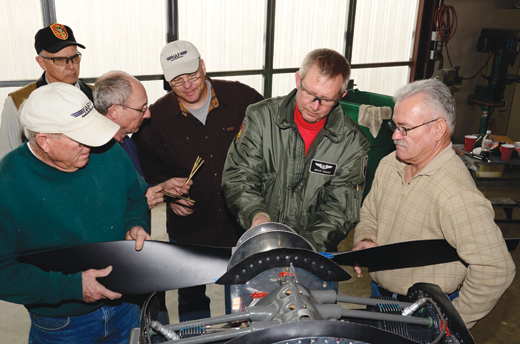
Mounting the new Cato Prop (left to right: Jay Pratt, Paul Dye, Steve Ingraham, Bruce Pauley and Roy Geer).
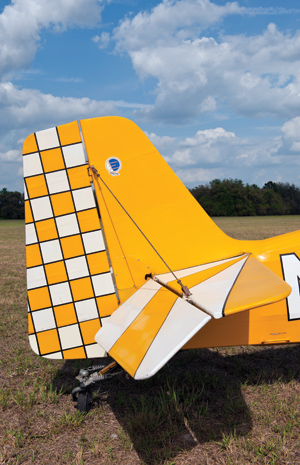
Probably the most personal of all contributions were the new wheelpants, molded by VanGrunsven himself from the original molds that he had stored in his barn since he built the airplane. He also molded a new lower cowl, but time and resources did not allow the team to have it fitted and finished before the tour. Hopes are high that this will be installed before the airplane goes on permanent display. Having these fiberglass parts made by Van was a real treat and reminded the team of his enduring affection for the airplane. He wanted it to look right, because then it would fly right.
Inspection Time
In early February, it appeared that the airplane was ready for a formal inspection. It had been a number of years since the last official condition inspection, and the prop (along with a few other items, such as the weight and balance) had changed, so Designated Airworthiness Representative Mel Asberry decided that the right thing to do was to renew the airworthiness certificate with a fresh inspection and put the airplane back into Phase I for 5 hours of testing. Several builders looked closely at the airplane before an official Condition Inspection was performed by an A&P. Then Asberry had his own look, asked for a few adjustments and added his signature to the logbooks, returning the airplane to service.
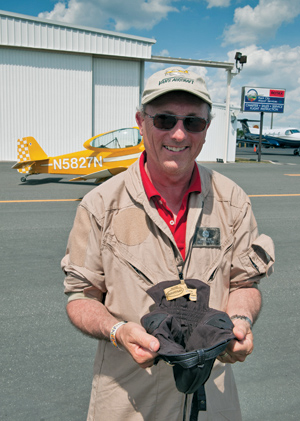
The author solicits donations to support the restoration and cross-country tour (just the way the barnstormers did long ago), using a leather flying helmet donated by Pop’s Leather.
A Slight Delay
As is true of many homebuilt aircraft projects, the airplane was “almost ready to fly” for about a month. Minor delays ensued as little problems popped up, and the winter winds on the Texas plains intervened, making it unwise to attempt a flight the first time the airplane was ready to go. Engine test runs and slow-speed taxiing were done instead, and the team found out that those Cessna dual-puck brakes were more than adequate to stop the airplane. They took a little getting used to, but the pilots who could fit into the cockpit quickly adjusted.
That last sentence deserves a little explanation. It turns out that the cockpit of the original Playboy was quite small, and that didn’t change when Van turned it into the RV-1. Anyone more than about 5 feet 10 inches tall has found it difficult to fit and safely manipulate the controls without bumping into some part of the structure. Long-legged pilots find their knees constantly hitting the bottom of the instrument panel—or their chins. The group has realized that a pilot’s inseam needs to be no longer than 30 inches, or it could be hard to properly manipulate the rudder and brakes. A great deal of discussion ensued about how Van himself (about 6 feet tall) fit in the airplane, with the conclusion being that he probably had another seat frame that folded him into the cockpit a little differently. He was probably a lot more flexible in those days as well.
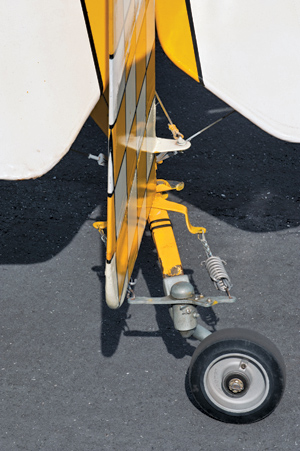
The tailwheel assembly was overhauled by Bob Avery of Avery Tools. VanGrunsven suggested that it might handle better on landing if the chains were loosened a bit.
The Reward
The big day for the restoration team finally came on February 19, 2012, after nearly a year of work. I made the airplane’s first flight, and it came through with flying colors. The airplane accelerated well and flew like all of the RVs that have followed, just a little slower. It is an “honest” airplane that has a reliable aerodynamic stall warning and good control. The elevator trimtab is a bit undersized, but the flaps are effective, and it is stable in the landing configuration. The airplane climbs well, and the engine runs like a charm. It was possible to get it down and stopped in approximately 1000 feet with minimal wind down the runway. Additional flights followed with Roy Geer at the controls, putting hours on the airplane to test its restored capabilities. I finished off the required 5 hours (and a little more), enjoying the opportunity to put the plane through its paces and experience a bit of what Van must have felt when he tried out his new airplane. Although we have limited it to non-aerobatic maneuvers because of its age, the RV-1 still turns nicely and handles well, the bubble canopy providing a beautiful view, just as its later sibling (the RV-3) does for new builders today. Within its tiny cockpit, I found a connection to a great many pilots and builders—past, present and future.
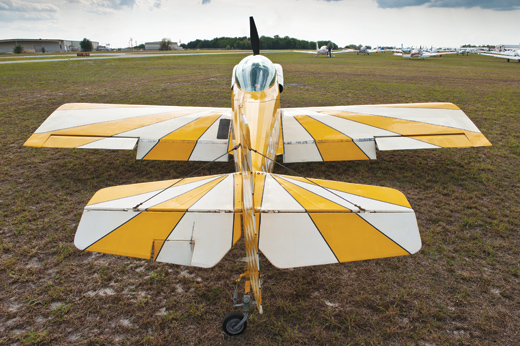
The previous owner painted the RV-1 to resemble Van’s original paint scheme. GLO Custom volunteered to touch it up and match the paint on the replacement pieces.
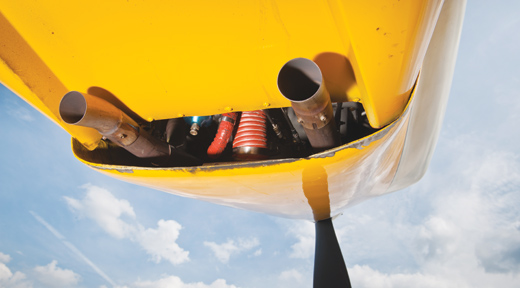
Van’s keen eye immediately noted that the lower cowl opening is lower than what he built, changing the cooling and the drag characteristics as well as the lines.
There is something special about flying an airplane with a history. So many aircraft have come from the creative mind of this little yellow airplane’s designer, and they have been thrilling countless pilots for four decades. With Phase I testing complete, the airplane was signed off to begin the cross-country tour that would take it to Oshkosh, Wisconsin, for induction into the EAA Museum. For the volunteers who worked on the project, the many vendors that contributed services and products and the community members who made financial donations when they couldn’t get to Fort Worth, the tour promised to be a triumph that would showcase Van’s creativity and allow builders and pilots to get an up-close look at this true original.
